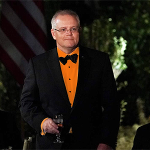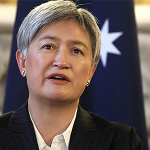Salah Rashad Zaqzoq/Wikimedia Commons
YJ-18 missiles on display.
While Biden bumbles, Xi threatens, Putin invades, and Kim fires missiles, there are more nuclear weapons pointed at the United States today than at any time since the end of the Cold War.
Arms control groups and non-nuclear countries worldwide are acutely aware that the US president ultimately decides if a nuclear war will occur. The upcoming election scares them. According to UN Secretary-General António Guterres, “Humanity is on a knife’s edge. The risk of a nuclear weapon being used has reached heights not seen since the Cold War.”
At the height of the Cold War in the mid-1980s, the Soviet Union’s nuclear arsenal peaked at 40,000 to 45,000 warheads. This massive arsenal included both strategic nuclear weapons for long-range strikes and tactical nuclear weapons for battlefield use.
The current nuclear powers include the United States, Russia, China, the United Kingdom, France, India, Pakistan, North Korea, and Israel. The United Kingdom and France, as NATO allies, are not likely to target the US. India and Pakistan focus their nuclear capabilities on regional adversaries, primarily each other. Israel’s unconfirmed nuclear arsenal is intended as a deterrent against threats in the Middle East, largely focused on Iran. Russia and China, however, pose significant threats with their arsenals aimed at the US and its allies in Asia and Europe. North Korea’s nuclear weapons are designed to deter US intervention and potentially target US territories and allies in the Asia-Pacific region, like Japan and South Korea.
Despite rumors to the contrary, Iran currently has no nuclear weapons but is actively working on developing them. When completed, these weapons are expected to be aimed at the United States and Israel.
This raises the question of how many nukes are pointing at the US. North Korea has roughly 50 nuclear bombs, including dozens of warheads on ICBMs capable of reaching the US. They have conducted multiple nuclear tests and developed ballistic missiles like the Hwasong-14, Hwasong-15, and Hwasong-17, the latter believed to carry multiple warheads. According to Law on DPRK’s Policy on Nuclear Forces Promulgated, North Korea’s strike policy emphasizes using its nuclear weapons as a deterrent against perceived threats, aiming to ensure regime survival and retaliate against any nuclear or significant military aggression from the US and South Korea. Experts believe North Korea is the country most likely to accidentally trigger a war. Additionally, under the new comprehensive strategic partnership with Russia, North Korea provides munitions to Moscow, raising fears that Russia will reciprocate by aiding North Korea’s nuclear technology advancements.
China is estimated to have around 410 nuclear warheads and is rapidly expanding its arsenal, with plans to reach up to 1,000 warheads by 2030. China’s ICBMs, including the DF-5, DF-31, and DF-41, can reach the United States. The DF-41, a road-mobile ICBM, can carry multiple independently targetable reentry vehicles (MIRVs), enhancing its strike capability. According to China’s 2023 National Defense Policy, the PRC maintains a “No First Use” (NFU) nuclear policy, pledging not to use nuclear weapons unless first attacked by an adversary using nuclear weapons. The policy also prevents the use of nuclear weapons against non-nuclear-weapon states.
Russia possesses the largest nuclear arsenal in the world, with an estimated 6,375 nuclear warheads, of which around 1,710 are deployed. This arsenal includes strategic and tactical weapons such as ICBMs like the SS-18 Satan, SS-27 Topol-M, and RS-24 Yars, submarine-launched ballistic missiles (SLBMs) like the Bulava, and air-launched cruise missiles (ALCMs). A significant portion of Russia’s nuclear weapons can target the United States.
The threshold for Russia’s use of nuclear weapons is lower than that of China or the US. According to the Kremlin’s Official Document on Basic Principles of State Policy of the Russian Federation on Nuclear Deterrence,” Russia could use nuclear weapons in response to an attack by a nuclear power, the use of weapons of mass destruction against it or its allies, significant conventional attacks on critical military sites, or any aggression that threatens the existence of the Russian state. Vladimir Putin has already made several nuclear threats regarding interference in the Ukraine war.
The Joint Comprehensive Plan of Action (JCPOA) aimed to limit Iran’s nuclear capabilities, but the US withdrew from the deal in 2018. Since then, Iran has repeatedly violated the terms, taking steps toward developing nuclear weapons. Iran has developed ballistic missiles like the Shahab-3 and Emad, capable of reaching regional targets. If Iran were to develop nuclear weapons, these missiles could potentially be adapted to deliver them.
When combining the nuclear arsenals of Russia, China, and North Korea, the total is approximately 6,755 to 6,765 warheads. While this is far below the 40,000 to 45,000 warheads at the peak of the Cold War, it is still enough to destroy the United States many times over. The nuclear threat from these countries presents a significant strategic challenge for the US. Russia and China pose the most immediate and substantial threats due to their extensive arsenals and advanced delivery systems, while North Korea’s unpredictable regime and developing capabilities are also of concern. Iran’s potential future development of nuclear weapons remains a critical issue that could alter the strategic balance in the Middle East and beyond.
Meanwhile, the man who holds the most powerful job on the planet, capable of causing or averting a nuclear war, demonstrated during the presidential debate signs of cognitive decline. Our nuclear-armed adversaries—China, Russia, North Korea, and Iran—watched and laughed.
The post Nukes Pointed at a Dithering President: Russia, China, and North Korea appeared first on The Gateway Pundit.








